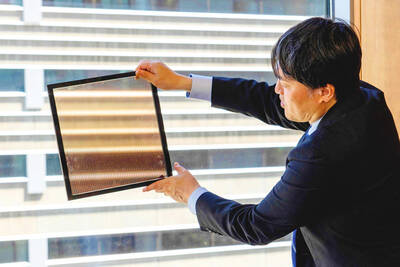Only about one third of the workers employed by companies at a major science park in central Taiwan are still being asked to take unpaid leave, park management said yesterday.
Central Taiwan Science Park (中部科學園區) Administration director-general Yang Wen-ke (楊文科) said that only 6,000 employees working for companies at the park remained on unpaid leave and he predicted that the number would further decline after June in view of the number of orders that the park has been receiving.
The number of workers forced to take unpaid leave at the park peaked at around 14,000 in December after the global financial crisis broke in September, Yang said.
Meanwhile, business turnover at the park in February totaled NT$10.3 billion (US$308 million), up by about 20 percent over the January figure of NT$8.6 billion, the park administration reported earlier this week.
The Central Taiwan Science Park, with facilities in Taichung City, Taichung County and nearby Changhua and Yunlin counties, houses more than 150 high-tech companies.
Meanwhile, the number of workers on unpaid leave in the nation’s export processing zones has been reduced by more than half to 11,000 from 26,000 prior to February, because firms have been receiving an influx of rush orders from China.
The Ministry of Economic Affairs’ (MOEA) Export Processing Zone Administration said on Wednesday that the recent announcements from upstream foundry companies, including Taiwan Semiconductor Manufacturing Co (台積電) and United Microelectronics Corp (聯電), of an end to their practice of forced unpaid leave had helped downstream packaging and testing firms to gradually increase their capacity utilization rate.
Major packaging and testing firms in the zones, including Taiwan’s Advanced Semiconductor Engineering Inc (日月光半導體) and NXP Semiconductors of the Netherlands, have seen their order visibility extend to May and June from the end of this month, the administration said.
Moreover, the zone’s administration said it would hold a job fair on Tuesday in the Nantze Export Processing Zone (楠梓加工出口區) in Kaohsiung County to hire 700 employees for backlight module maker Chi Lin Technology Co (奇菱科技).
“This will be the first large-scale hiring event held in the export processing zones since the financial crisis began,” an administration official said.
The administration said it had seen signs of economic recovery following the six-month downturn that was sparked when the economy suddenly deteriorated in the fourth quarter of last year.
“Many firms in the zones have continued to receive orders after the Lunar New Year holiday,” administration deputy director Dai Ruei-ching (戴瑞卿) said. “Many one-month rush orders have even become short-term orders for two to three months, which helps improve the capacity utilization rate.”
Dai said many electronics firms in the zones had begun to cancel unpaid leave in the middle of last month. However, whether the rush order effect will continue would require another month or two of observation.
The administration’s statistics showed that firms in the zones laid off a total of 4,186 employees in the last four months of last year and another 1,912 employees in the first three months of this year.
The export processing zones currently house around 200 firms that employ a total of 56,000, the report said.

UNCERTAINTIES: Exports surged 34.1% and private investment grew 7.03% to outpace expectations in the first half, although US tariffs could stall momentum The Chung-Hua Institution for Economic Research (CIER, 中華經濟研究院) yesterday raised its GDP growth forecast to 3.05 percent this year on a robust first-half performance, but warned that US tariff threats and external uncertainty could stall momentum in the second half of the year. “The first half proved exceptionally strong, allowing room for optimism,” CIER president Lien Hsien-ming (連賢明) said. “But the growth momentum may slow moving forward due to US tariffs.” The tariff threat poses definite downside risks, although the scale of the impact remains unclear given the unpredictability of US President Donald Trump’s policies, Lien said. Despite the headwinds, Taiwan is likely

When Lika Megreladze was a child, life in her native western Georgian region of Guria revolved around tea. Her mother worked for decades as a scientist at the Soviet Union’s Institute of Tea and Subtropical Crops in the village of Anaseuli, Georgia, perfecting cultivation methods for a Georgian tea industry that supplied the bulk of the vast communist state’s brews. “When I was a child, this was only my mum’s workplace. Only later I realized that it was something big,” she said. Now, the institute lies abandoned. Yellowed papers are strewn around its decaying corridors, and a statue of Soviet founder Vladimir Lenin

UNIFYING OPPOSITION: Numerous companies have registered complaints over the potential levies, bringing together rival automakers in voicing their reservations US President Donald Trump is readying plans for industry-specific tariffs to kick in alongside his country-by-country duties in two weeks, ramping up his push to reshape the US’ standing in the global trading system by penalizing purchases from abroad. Administration officials could release details of Trump’s planned 50 percent duty on copper in the days before they are set to take effect on Friday next week, a person familiar with the matter said. That is the same date Trump’s “reciprocal” levies on products from more than 100 nations are slated to begin. Trump on Tuesday said that he is likely to impose tariffs

Japan is heavily investing in a new kind of ultra-thin, flexible solar panel that it hopes will help it meet renewable energy goals while challenging China’s dominance of the sector. Pliable perovskite panels are perfect for mountainous Japan, with its shortage of flat plots for traditional solar farms. A key component of the panels is iodine, something Japan produces more of than any country but Chile. The push faces some obstacles: Perovskite panels contain toxic lead, and, for now, produce less power and have shorter lifespans than their silicon counterparts. Still, with a goal of net zero by 2050 and a desire to